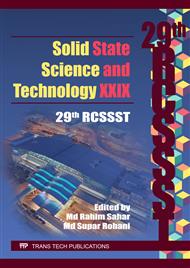p.338
p.343
p.347
p.352
p.358
p.365
p.370
p.374
p.379
Effects of Sodium Iodide (NaI) on Electro-Conductivity with Polyurethane-Diol Organic Electrolyte for Dye-Sensitized Solar Cell (DSSC)
Abstract:
Dye Sensitized Solar Cells (DSSC) technology using inorganic electrolytes post problem in solvent evaporation and iodine sublimation (corroding contacts) causing instability of cells. Application of low molecular oligomers is progressing recently for an improved performance. The electrolyte system was aimed for improving electrochemical stability using quasi-solid-state electrolytes from organic capped polymers. A photo-electrochemical cell was developed from bio-based polyurethane diol (PU) polymer electrolyte with Sodium iodide (NaI) as conducting electrolyte transport material. In this study, polyurethane-diol was modified with NaI cations in the hydrothermal chemical reaction to form modified polyurethane-diol electrolyte. The chemical structure of polyurethane-diol and NaI have achieved highest conductivity of 8.06x10-5 S.cm-1 where structural of polyurethane-diol with NaI shown redox Fermi vectorial energy transfer evaluated for performance of efficiency. Stable cell for DSSC system require material properties to be invidually optimized in views of various elemential performances and solar cell of FTO/TiO-Pc/PU-NaI-I2/Ac give a response under light intensity of 100 mW cm−2 and indicated efficiency of power generation of 4 mW where photovoltaic effect of current density, Jsc of 0.04 mA.cm−2 and open circuit voltage, Voc of 0.4 V respectively.
Info:
Periodical:
Pages:
358-362
Citation:
Online since:
October 2017
Authors:
Price:
Сopyright:
© 2017 Trans Tech Publications Ltd. All Rights Reserved
Share:
Citation:


